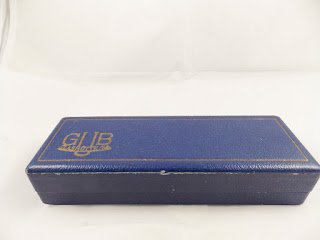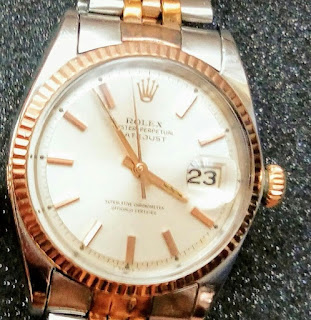Owing to my love of history, I have collected a few of the Glashutte vintage watches mdae from the previous East Germany. There are a few models for the vintage Glashutte diver made in Germany. This model for me is the best looking Glashutte diver cal 11-27.
It has a larger case:
chrome plated; diameter excl. crown approx 38mm; lug to lug approx. 46mm; lug
width 20mm. Vintage
military diver wristwatch GUB Glashutte with famous 22
jewels automatic Spezichron caliber 11-27, Only 72.000 movements of this type
were produced in Germany in 1970s under the previously Eastern block GUB (Glashütter Uhrenbetriebe). The Glashutte company was
privatised to become Glashütte Original in 1994.
Talking about relaunching an old model, for
a story on the Relaunch of the Glashutte , please see below:
https://monochrome-watches.com/glashutte-original-sixties-comparing-old-new/
For this story we have to travel back in time to 2007, when the German watch manufacture Glashütte-Original introduced a new model that was heavily inspired on a vintage model. It was more of a modern version of a vintage timepiece that was made during the (from 1949 to 1990 the eastern part of Germany was occupied Soviet forces), and it shared pretty much all of its looks right down to the smallest details; except now the materials used are of modern standards. We put them side by side… a vintage Glashütte Uhren Betrieb (GUB) hand-wound watch and a modern Glashütte-Original Sixties.
As a side note – that is certainly of some importance – I have to say that the vintage example is mine. I cannot recall the exact date of purchase, however it was early 2007, around the time when Glashütte-Original introduced the Senator Sixties at the 2007 Baselworld fair. When I bought it, I had no idea that the high-end watchmaker from Glashütte in Saxony, Germany, was about to launch a model that is not just inspired on, but almost a perfect modern iteration of the old watch. Today we’re going to review that new watch, and for history’s sake, we keep my vintage GUB next to it.
A bit of historyGlashütte Original as we know it today, was founded in 1994 by the privatization of VEB Glashütter Uhrenbetriebe , or short GUB. After the Russians took control over the Eastern part of Germany, shortly after World War II, GUB was formed in 1951 as an East German conglomerate comprising all watch companies based in Glashütte. Today Glashütte Original produces its own movements, and their watches are in the higher echelons of the watch market. Glashütte Original is currently owned by The Swatch Group.
Overview
Leaving my old GUB out of the equation, the Glashütte-Original Sixties (formerly known as Senator Sixties) is a charming, pleasantly priced, comfortably wearing, dress watch with a more than average nod to yesteryear. The Sixties indicates, as one might expect from a proper dress watch, hours, minutes and seconds. Time only thus. And with a diameter of only 39mm and a relatively slender profile of 9.4mm it also qualifies as thoroughbred dress watch. With these dimensions the Sixties also wears quite comfortably and while it’s not the biggest watch, it has quite some wrist presence. Maybe that’s due to the rather large, open and clean silver face with minimal writing on the dial. What it all comes down to, is that the GO Sixties is a very charming dress watch, with a very nice and reliable in-house movement, and a dose of interesting feats… let’s have a closer look!
Case and strap
The round 39mm 18K rose gold case measures 9.4mm thick, and part of its thickness is debted to the domed sapphire crystal. Although the domed crystal makes this watch thicker, it also resembles the domed plexi crystal of the old GUB. The lugs are more shaped than on the old GUB, however both the old and the new feature a quite thin bezel, leaving a large opening for the dial. The watch is water resistant to 30 meters, so not for swimming, showering or diving, however rain and washing hands should not harm the watch.
While 99% of all luxury watches with an alligator strap come on a alligator strap with large scales, GO opted for an alligator strap with small scales. Rather unusual, however I find it a much better fit on such a vintage inspired watch! The strap is closed by a tang buckle with the brand’s double-G logo engraved.
DIAL AND HANDS
The dial and hands are actually the parts of this watch that resembles the old GUB the most. Similarities go further than just the numbers 3, 6, 9 and 12. The dial is domed like on the old GUB, and the hands are baton style hands, and on both the old and new filled with luminescent material. The hour markers are applied stick markers and next to each hour marker is a small luminescent dot, for better legibility at night.
Several years ago, Glashütte-Original bought a dial making factory and now they are able to make their own dials. The result, besides more control over delivery times and quality, is that they can also play more with ‘funky’ colours and even patterns on the dial, like they did for the Sixties Iconic Collection ()
MOVEMENT
Glashütte-Original’s in-house movement, calibre 39-52, is visible through a lovely ‘box’ sapphire crystal. This means that you can look through the side of the crystal as well, to observe the movement from various angles. On the down-side, the movement is quite a bit smaller than the case, and the movement holder (metal ring around the movement) is also clearly visible. Glashütte-Original used the ring not only to hold the movement in place, but also engraved with the word “automatic”. Altogether I think GO did something very nice and novel, with the box sapphire and I think it would not have worked very well with a larger movement.
The movement finishing is really nice and features so-called Glashütte ribbing (the German equivalent of Côte de Genève) on the three-quarter plate, balance cock and skeletonized rotor. The latter features a 21k gold oscillator weight, for improved inertia, and is adorned with the Glashütte-Original double-G logo. The watch is regulated by a swan-neck fine adjustment.
The edges are bevelled and all steel parts are polished (by hand of course); even the rim of the balance is polished, and therefore looks much better than the average balance. The finishing is certainly on par with, if not above, most of its direct competitors in the same price range, and delivers outstanding value for money.
Calibre 39-52 only indicates time, by three central hands (hours, minutes and seconds), and has a power reserve of approx. 40 hours. This movement, part of the calibre 39 family, is a solid and reliable movement, which has been in production for a few decades.
Conclusion
In terms of styling, the Glashütte-Original Sixties is very close to my old GUB, and more importantly, it looks fabulous. Size-wise its more modern, with a 39mm diameter, and I’m happy that it’s not 40mm or more. In this rose gold execution the watch is a proper dress watch, although its ‘sixties style’ dial adds some flair to what could be a standard classic dress watch. The domed sapphire crystal in front, and the box sapphire as case-back also add a lot of flair, and that’s certainly something that will please those who like vintage dress watches, and want to enjoy it in a contemporary quality. It’s more water resistant than my old GUB, and probably better suited for daily wearing.
The Sixties also comes in 18K rose gold with a black dial, and in stainless steel with silver, black or blue dial. The price is very reasonable and starts at € 6.300 euro for the stainless steel models, and € 12.600 for both rose gold versions. Altogether a very charming watch, with great features that will certainly bring pleasure, and a very pleasant price point.
More info at the .
TECHNICAL SPECIFICATIONS – GLASHÜTTE-ORIGINAL SIXTIES
- Case: 39mm diameter – 18k rose gold – domed sapphire crystal in front, box sapphire crystal in case-back – 30m water resistant
- Movement: Calibre 39-52 in-house movement – self-winding – 40h power reserve – 25 jewels – 28,800vph – three centrals hands for hours, minutes and seconds – three-quarter plate with Glashütte ribbing – swan-neck fine adjustment – 18k gold oscillating weight
- Strap: alligator leather strap with 18k rose gold pin buckle
- Variations: 18k rose gold with black dial, and in stainless steel with silver, black or blue dial.
- Price: € 6.300 EUR for the stainless steel version, and € 12.600 EUR for the 18k rose gold versions























































